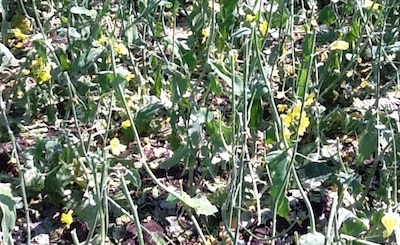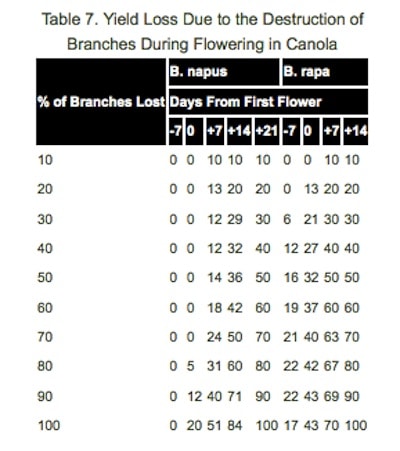
Heat. Foliar boron applied at flowering has been tested on canola in Ontario to as a way to prevent blossom blast during summer heat waves. Four years of grower field studies from 2008-11 found inconclusive results. Hail. Nutrient and fungicide top dress treatments have also been promoted to help heal and restart canola after hail. We don’t have published studies on using these treatments for this purpose in Western Canada, so it’s buyer beware. Leave a check strip to see if they improved yield.
Note that for products that require foliar uptake to work properly, severe hail damage may have striped the leaves, reducing the surface area available for absorption by the plant.
Top dressing N and S on hailed crop. Nitrogen and sulphur are taken up through roots, for the most part, and so lost leaf area is not a concern for uptake. A treatment of 10-15 pounds of N and 5 pounds of S may replace nutrients lost to defoliation, but check that the crop has a good chance of recovery before investing more into it. Look for new leaves from the growing point or for resumed flowering. This may take a few days to show up after a hail storm. Remember that a crop that does recover from hail will be delayed, and that a nitrogen top up could delay it further. Consider whether the crop still has enough time to mature in a typical season.

Stage of the crop when hail hits will also determine its ability to recover. Hail before 20% flowering will have a much lower, even negligible, effect on yield potential. (See the table at right.) Hail after 20% flower will have a lasting effect on yield potential. Heavy hail at late flower or podding stages will result in much higher yield loss — maybe even a complete wipe out. More mature plants simply have less opportunity to regrow.
If risk of sclerotinia stem rot infection was already moderate to high prior to hail damage, the open wounds, decaying plant matter in the canopy and potentially longer flowering period of recovering plants may help facilitate infection. But if risk wasn’t high before, then it won’t necessarily increase substantially just because of the hail. Give the crop some time to recover, then reassess if the crop left is still worth protecting and whether the subsequent crop canopy and conditions truly represent a high risk for sclerotinia.
